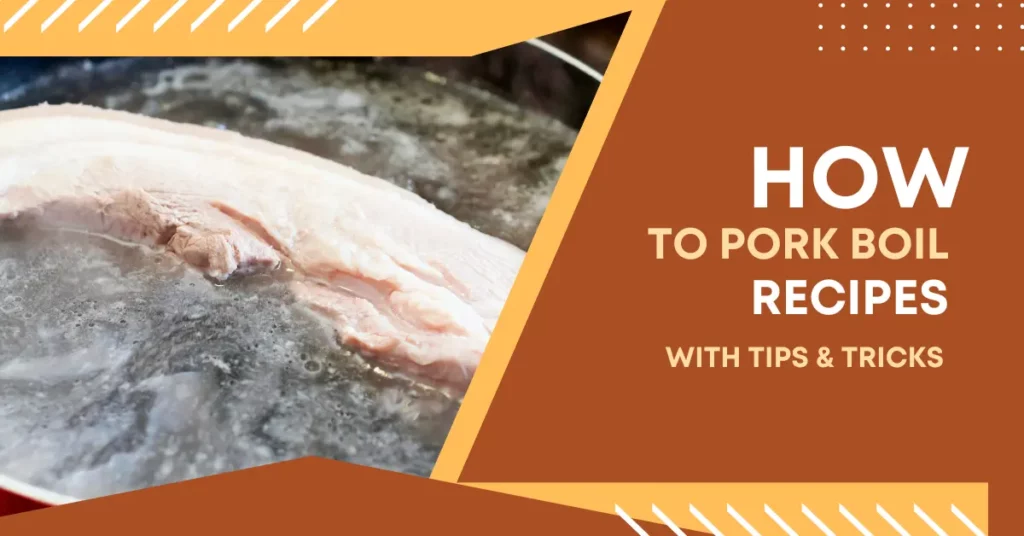This post may contain affiliate links. If you use these links to buy something we may earn a small commission. Thanks.
Boiling pork is a simple yet effective cooking method that results in tender, flavorful meat. Whether you’re preparing pork for soups, stews, or shredded dishes, knowing the correct boiling time ensures a perfect texture and taste. The duration required to boil pork depends on several factors, such as the cut, size, bone-in or boneless meat, and the desired tenderness. In this comprehensive guide, we’ll break down the boiling times for different pork cuts, provide a step-by-step boiling method, and share tips for achieving the best results.
General Boiling Times for Different Pork Cuts
The boiling time for pork varies depending on the cut and thickness of the meat. Here’s a general guideline:
- Pork Chops: 25-30 minutes
- Pork Ribs: 45-60 minutes
- Pork Shoulder (for pulled pork): 1.5-2 hours
- Pork Belly: 1-1.5 hours
- Pork Tenderloin: 30-40 minutes
- Pork Bones (for broth or stock): 2-3 hours
Each cut requires different cooking times due to its fat content, muscle density, and connective tissues. Slow boiling is often recommended to break down the fibers and achieve optimal tenderness.

Step-by-Step Guide to Boiling Pork
Step 1: Preparation
Before boiling pork, proper preparation is crucial:
- Choosing the Right Cut: Select the pork cut that best suits your recipe. For soups and stews, pork shoulder or ribs work well. If you need tender, lean meat, opt for pork tenderloin.
- Cutting into Smaller Pieces: If you want to reduce cooking time, cut the meat into smaller chunks. However, for dishes like pulled pork, boiling larger pieces helps retain moisture.
- Rinsing the Meat: Rinse pork under cold running water to remove excess blood and impurities.
Step 2: Boiling Process
- Start with Cold or Hot Water?
- Adding pork to cold water allows it to cook gradually, making the meat tender.
- Adding pork to boiling water seals the exterior quickly, preserving juices inside.
- Using Aromatics and Seasonings
- Enhance the flavor by adding garlic, onions, bay leaves, peppercorns, ginger, or any preferred spices.
- For richer broths, include vegetables like carrots, celery, and leeks.
- Simmering vs. Rapid Boiling
- Always bring the water to a gentle simmer rather than a rolling boil. A rapid boil can toughen the meat and cause it to become chewy.
- Skim off any foam or impurities that rise to the surface for a clear broth.
Step 3: Checking for Doneness
- Use a Meat Thermometer: The USDA recommends an internal temperature of 145°F (63°C) for pork. However, for shredded or fall-apart pork, a temperature of 195-205°F (90-96°C) is ideal.
- Fork Test: If the meat easily pulls apart with a fork, it’s done.
- Taste and Adjust: If necessary, continue boiling for additional tenderness.
Tips for Best Results
- Avoid Overcooking: While boiling can make pork tender, excessive boiling can dry it out. Monitor the cooking time carefully.
- Use Broth Instead of Water: Instead of plain water, consider using a broth or stock to enrich the flavor.
- Add Vinegar or Citrus: A splash of vinegar or lemon juice can help break down the meat fibers, making it more tender.
- Let Pork Rest After Boiling: Once done, let the pork rest for a few minutes before cutting or shredding. This helps retain juices.
Common Uses for Boiled Pork
Boiled pork is a versatile ingredient that can be used in numerous recipes:
- Shredded Pork Tacos: Slow-boiled pork shoulder can be shredded and seasoned for tacos.
- Pulled Pork Sandwiches: After boiling, mix with BBQ sauce for a classic pulled pork sandwich.
- Broiled or Stir-Fried Pork: Boiled pork can be further cooked in a stir-fry or broiled for additional texture.
- Soups and Stews: Use boiled pork as a base for hearty soups like ramen, pozole, or pork bone broth.
Conclusion
Boiling pork is a straightforward yet rewarding cooking method that yields tender and flavorful meat. By understanding the right boiling times for different cuts, using aromatics for enhanced taste, and following best practices for cooking, you can make the most out of boiled pork in various dishes. Whether you’re making a rich pork broth or preparing shredded pork for sandwiches, following these steps ensures delicious results every time.
Experiment with different seasonings and techniques to create a dish that suits your taste preferences. Happy cooking.
